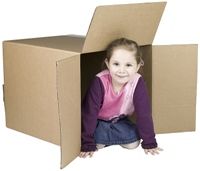Children and Creativity: The Joy of the Box
Written by Karen Meeker
 I recently viewed a YouTube video of a young child tossing an impressive pile of playthings out of a toy box, only to climb into the empty receptacle and sit contentedly. That was a clear demonstration of the joy of the box.
I recently viewed a YouTube video of a young child tossing an impressive pile of playthings out of a toy box, only to climb into the empty receptacle and sit contentedly. That was a clear demonstration of the joy of the box.
Over the years I’ve witnessed a phenomenon I’ll call the joy of the box. It is a curious and fascinating thing to behold, for regardless of its contents, a young child often seems more intrigued by the box itself. As I watch this scene repeat itself on various occasions and with different children, I wonder what is so special about a receptacle made of plastic or cardboard?
The allure of little spaces
When our children were young, I don’t remember boxes so much as a card table with a blanket draped over it to form a tent. That was the place where lots of imaginary scenarios took place, and they could stay happily occupied for long periods of time (a relief to a busy mom who didn’t have to wonder where the children were and what they were doing).
When our grandchildren came along, though, I got to see amazing transformations and innovations using the lowly box. For instance, I saw a miniature house positioned in the corner of the living room that had rooms made of assorted sizes of boxes, connected by rough cut doors and windows, and decorated with markers. It was complete with a small toy stove for the kitchen area.
Many hours were spent under the watchful eye of a very patient mother as her daughters imagined and played “house” to their hearts’ content.
And then there was the wardrobe box that became an elevator, complete with custom-cut doors and precision-drawn buttons. It was a couple of days in the making, but brother and sister finally achieved their pièce de résistance and delighted parents and grandparents alike with their magnificent feat. It actually held passengers—well, two small ones—who were content enough to be in an elevator that went nowhere.
A keeper of treasures
In one of our many moves one of our young daughters lost something that to this day (perhaps 30 years later) she laments. It was a small box that contained her miniature porcelain Peter Rabbit and his siblings. She loved it and had kept it safely in its own special place in her room. Sad to say, it probably got pitched in all the confusion of moving boxes and piles of trash.
 Not long ago I found a little box that had been left at church. Inside was a miscellany of items, none of which seemed that notable to older eyes. Not knowing who it might have belonged to, I took it to services the next week and was immediately approached by a grandmother. “You found his box!” she exclaimed happily. Her young grandson had fretted that whole week because it contained some of his most valued treasures. How easily it could have been swept up and thrown away with scarcely a thought.
Not long ago I found a little box that had been left at church. Inside was a miscellany of items, none of which seemed that notable to older eyes. Not knowing who it might have belonged to, I took it to services the next week and was immediately approached by a grandmother. “You found his box!” she exclaimed happily. Her young grandson had fretted that whole week because it contained some of his most valued treasures. How easily it could have been swept up and thrown away with scarcely a thought.
Sometimes simple is best
Sometimes we equate value with price. Expensive high-tech toys must be better than a mere box—right? Not necessarily. Consider the following benefits:
- Boxes are the fertilizers of a fruitful imagination. Potential can bloom in the eye of the beholder.
- Creating with boxes encourages the ability for independent play—a safeguard against that dreaded phrase, “I’m bored.”
- Creating with boxes encourages creative problem solving. For example, how do you make a door that opens and closes?
- Unique possibilities are presented with each new box.
- Creating with boxes encourages resourcefulness.
- Such activities give parents opportunities to “pretend” right along with their children, inserting a life lesson when appropriate.
- Frustration levels can be minimized as parents are able to give help with developing skills. (Technology, on the other hand, often increases frustration in both children and parents who struggle to understand the instructions and master the learning curve.)
- Last and best of all: boxes cost virtually nothing, need no batteries and are recyclable.
Patience: inquiring mind development in progress
Please remember, there is a learning process at work here, and sometimes messes happen. But take heart, they generally do not last forever. As a grandmother who reflects often about where the time has gone, I encourage you to just sit back and delight in the joy of the box. You’ll be glad you did.
Grandmother Karen Meeker loved seeing creativity at work in her young grandchildren and has folders of their original artwork and stories carefully filed away, waiting to be shared with yet another creative generation.
For related material about parenting, creativity and more, see:








